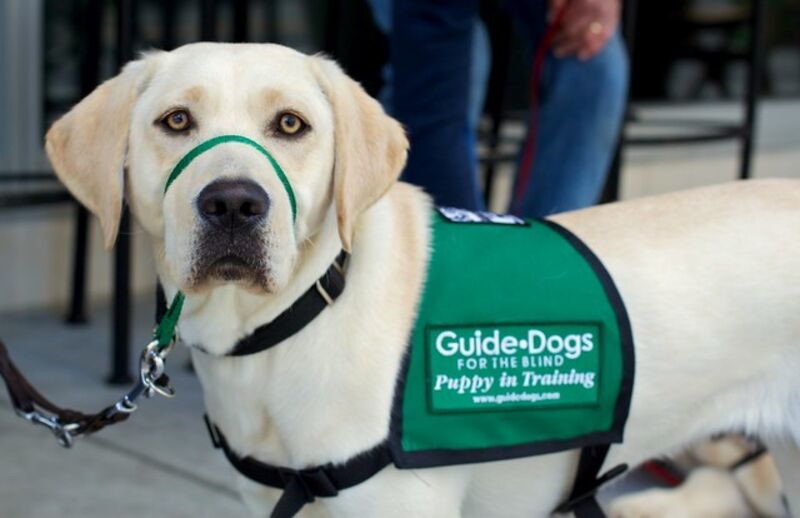
As you may know, I am lamenting the end of my favorite TV show, Game of Thrones. I now have to wander through my Hulu, Netflix, and HBO queues to find my next binge-worthy show. On Hulu, I stumbled upon a fantastic documentary, Pick of the Litter, about service animals. This blog may spoil aspects of the documentary if you haven’t seen it already. And a friendly note: at the RMADAC, we don’t advocate or endorse any particular service animal program. It is up to each individual to decide what works best for them based on their needs. Finding a reputable service dog program or trainer will have to be a blog post for another day. For now, keep in mind this is one of many programs trying to meet the need for service animals.
Warning: If happy stories about animals and the people who love them make you a little weepy, prepare your tissues.
This documentary follows the journey of five puppies from Guide Dogs for the Blind. The journey starts the day they are born, wet and wiggling. After 8 weeks with their mom and littermates, they join their puppy-raiser family. Patriot, Poppet, Phil, Primrose, and Potomac are service dog prospects, and have a lot to learn before they are entrusted with the life of their Blind handler. They use the term prospect because the puppies have the potential, but there are no guarantees they will succeed. Even the best-bred puppies, coming from generations of guide dogs, and provided the best training possible, may not graduate to guide dog work. Guide Dogs for the Blind (GDB) accepts 1,100 applications for guide dogs per year. Of the 800 puppy prospects born at GDB each year, only 300 of those make it all the way to become guides. More than 14,000 teams have graduated since 1942. There are approximately 2,200 active guide dog teams from this program alone currently in the field across North America.
Some of the obstacles the puppies and their raiser face are identical to any puppy. They must master potty training, playing gently, walking on a loose leash, not jumping up, impulse control, and ignoring distractions. One puppy was reassigned to a new family with more experience due to his spirited and independent personality.
There are some issues puppy-raisers must face, that have “make -it-or-break-it” consequences for the service dog prospect. Although all breeding pairs are health tested to have the highest probability that the puppies will not inherit genetic diseases, issues with eyes and hips can still occur. Other times, a dog’s personality and resulting behavior do not match the needs for a Blind handler. Although they only breed the animals with the best temperaments, there is always the element of Nurture to go along with their innate Nature. An ideal service animal will be confident, calm, and able to problem solve when issues arise in their environment. For example, the program specifically trains their dogs to disobey commands which might put their handler in danger. If their handler asks the dog to go forward, and the dog can see an oncoming car, they must disobey that command to keep their handler safe. A dog that is easily distracted, or does not have the confidence to intelligently disobey, cannot be a guide dog.
If a dog cannot meet the high standards required for a guide dog, they are “career changed”. This is GDB’s polite euphemism, meaning a dog is unsuitable for guide work and has been cut from the program. Their first option is to be returned to their puppy-raiser to be their pet. This was the fate of one of the five puppies. Another was chosen to join the breeding colony. Only the best of the best can contribute to the next generation of guide dogs. Other “career change” options include joining the K9 Buddy Program for youth who are blind or low vision. Outside of GDB, many of dogs go on to help humans with search and rescue, medical alert work, or pet therapy. You can even apply to adopt a career changed dog yourself!
Although the show does focus on the dogs, it also shares the experience of people receiving the dogs. One woman’s former guide dog was attacked while out in public and was traumatized and unable to continue guide work. She lost part of her freedom when she had to return to using a cane to navigate. Another individual received his first ever dog and was looking forward to having greater confidence to go hiking. The labor of love the puppy-raisers underwent were all so that these strangers could have freedom and independence. It takes a village, and GDB estimates that 250 volunteers play a part in the training of any single guide dog.
Watch this documentary if you need a feel-good story about disability and the human/canine connection or want to know what goes into training a guide dog. As always, if you want more information on service animals, get in touch with us here at the Rocky Mountain ADA Center. We’ll be happy to talk about puppies – and the occasional miniature horse.